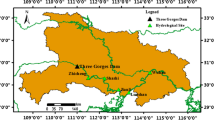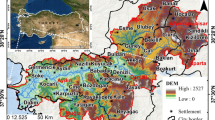Abstract
Geoelectric (GE) field data are usually interpreted using GE computer-codes. A back propagation (BP) ANN model is used to predict hydro-sedimentology (HS) well logs. Both twenty-six sets of existing well logs from Golgohar iron mine and data from 26 Schlumberger GE apparent resistivity surveys were used as inputs for the ANN model. This data file was used to expend ANN models during the learning and testing phases of the modeling and the results were compared with the HS logs of the drilled wells. The learning phase file was included 20 records and the testing phase 6. The Professional II/Plus computer-code was used to make the various ANN models. In this stage, two techniques were employed: (1) incorporating hydro-sedimentology (HS) codes, (2) switching the GE field-observed scatter diagram to a digit string. None of the model results were able to satisfy the authors’ expectations, possibly due to inadequate input data, so the model was optimized in second stage using the third novel technique that could complete it: using both field data and interpreted GE computer-code (IPI2Win) results as appended input data. The best BP-ANN model had three hidden layers, and a DBD learning rule, sigmoid transfer function, and epoch learning of 15,000,000 with 0.000007 Root Mean Square (RMS) error and provided better conformity between predicted and observed HS logs. Employing 3 mentioned techniques was useful for locating a new drainage well at the Golgohar mine.
Zusammenfassung
Geoelektrische (GE) Felddaten werden regelmäßig durch den Einsatz von GE-Computerprogrammen interpretiert. Wir verwendeten ein auf Fehler-rückführung (back propagation, BP) beruhendes ANN-Modell, um die Hydro-Sedimentologie (HS) aus Bohrlochaufzeichnungen vorherzusagen. Sechsundzwanzig existierende Bohrlochprotokolle von der Golgohar-Eisenmine und Daten von 26 Schlumberger GE-Messungen des scheinbaren Widerstands im Untergrund wurden als Eingabe für das ANN-Modell verwendet. Die GE-Daten wurden in den Lern- und Testphasen der Modellierung in ANN-Modellen verwendet und die Ergebnisse wurden mit den HS-Aufzeichnungen der Bohrlöcher verglichen. Die Lernphase wurde mit 20 Datensätzen und die Testphasen mit sechs Datensätzen betrieben. Der Computercode Professional II/Plus wurde verwendet, um die ANN-Modelle und die Vergleichsroutine zu erstellen. Keines der getesteten Modelle war in der Lage, unsere Erwartungen zu erfüllen, möglicherweise aufgrund unzureichender Eingabedaten. Daher wurde das Modell mit drei neuen Techniken optimiert: 1) Einbeziehung von Hydro-Sedimentologie (HS)-Programmen, 2) Verwendung sowohl der Felddaten als auch der mittels GE-Computercode (IPI2Win) interpretierten Ergebnisse als angehängte Eingabedaten und 3) Umschalten des GE-Feldbeobachtungsdia¬gramms auf eine Ziffernfolge. Das beste BP-ANN-Modell hatte drei verborgene Ebenen und eine DBD-Lernregel, eine sigmoide Transfer¬funktion und einen Epochen-Lernprozess von 15.000.000 mit einem quadratischen Fehler von 0,000007 und lieferte eine bessere Überein¬stimmung zwischen den vorhergesagten und den beobachteten HS-Protokollen. Diese Techniken sollten nützlich sein, um neue Bohrungen in der Golgohar Mine und anderswo anzupeilen.
Resumen
Los datos de campo geoeléctricos (GE) se interpretan regularmente usando códigos de computadora GE. Usamos un modelo ANN de retropropagación (BP) para predecir los registros de pozo de la hidro-sedimentología (HS). Veintiséis conjuntos de registros de pozos existentes de la mina de hierro Golgohar y los datos de 26 estudios de resistividad aparente de Schlumberger GE se utilizaron como insumo para el modelo ANN. Los datos de GE se usaron en modelos ANN en las fases de aprendizaje y prueba del modelado y los resultados se compararon con los registros de HS de los pozos perforados. La fase de aprendizaje se llevó a cabo utilizando 20 registros y las fases de prueba con seis registros. El código de la computadora Professional II / Plus se usó para hacer los modelos ANN y para el proceso de comparación. Ninguno de los modelos probados fue capaz de satisfacer nuestras expectativas, posiblemente debido a datos de entrada inadecuados, por lo que el modelo fue optimizado utilizando tres nuevas técnicas: 1) incorporación de códigos de hidro-sedimentología (HS), 2) utilizando datos de campo y resultados de código de computadora interpretada por GE (IPI2Win) como datos de entrada y, 3) cambiando el diagrama de dispersión GE observado en campo a una cadena de dígitos. El mejor modelo BP-ANN tenía tres capas ocultas, una regla de aprendizaje DBD, función de transferencia sigmoidea y aprendizaje de época de 15.000.000 con una raíz cuadrada de la varianza de 0,000007 y proporcionaba una mejor conformidad entre los registros de predicción y observación del SA. Estas técnicas deberían ser útiles para ubicar nuevos pozos en la mina Golgohar y en otros lugares.
抽象
通常,人们用地电(GE)计算程序解释地电(GE)野外数据。本文应用反向传播人工神经网络模型(ANN)预测水文-沉积(HS)测井。以Golgohar铁矿26套已有测井数据和26 套Schluberger GE视电阻率勘探数据作为人工神经网络(ANN)模型输入。地电(GE)数据用以ANN模型的学习和检验,实测水文-沉积(HS)测井数据用以与ANN模型结果对比。学习阶段用20个记录,检验阶段用6个记录。用Professional II/Plus程序进行ANN建模和结果对比。由于输入数据量不足,模型都未达预期效果。因此,采用以下三种新方法优化:1)结合水文-沉积(HS)程序;2)同时用野外和地电(GE)IPI2Win解释结果作附加输入数据;3)将地电(GE)野外观测散点图转化为数串。优化后的最佳反向传播人工神经网络模型(BP-ANN)具有三个隐藏层、一个DBD学习规则、一个反曲转换公式和15,000,000个初相学习(均方根误差0.000007),预测值与观测水文-沉积(HS)值一致性更好。该技术可应用于Golgohar或其它矿的排水井定位。










Similar content being viewed by others
References
Adamowski J, Fung Chan H (2012) A wavelet neural network conjunction model for groundwater level forecasting. J Hydrol 407(1–4):28–40
Al-Ruwaih FM, Ben-Essa SA (2004) Multi-well and multi-tracer tests to characterize the groundwater aquifers in southern Kuwait. Bull Eng Geol Environ 63:57–70
Aminian K, Ameri S (2005) Application of artificial neural networks for reservoir characterization with limited data. J Petrol Sci Eng 49:212–222
Banerjee P, Singh VS, Chattopadhyay K, Chandra PC, Singh B (2011) Artificial neural network model as a potential alternative for GW salinity forecasting. J Hydrol 398(3–4):212–220
Bhatt A, Helle HB (2002) Committee neural networks for porosity and permeability prediction from well logs. Geophys Prospect 50:645–660
Chang J, Wang G, Mao T (2015) Simulation and prediction of Suprapermafrost GW level variation in response to climate change using a neural network model. J Hydrol 1211–1220
Chen C, Wei C, Liu H, Hsu N (2014) Application of neural networks and optimization model in conjunctive use of surface water and GW. Water Resour Manag. https://doi.org/10.1007/s11269-014-0639-6
Coulibaly P, Anctil F, Aravena R, Bobee B (2001) Artificial neural network modeling of water table depth fluctuations. Water Resour Res 37(4):885–896
Dorrington KP, Link CA (2004) Genetic-algorithm/neural-network approach to seismic attribute selection for well-log prediction. Geophysics 69:212–221
Emamgholizadeh S, Moslemi K, Karami G (2014) Prediction the groundwater level of Bastam Plain, Iran by artificial neural network, ANN and adaptive neuro-fuzzy inference system, ANFIS. Water Resour Manag. https://doi.org/10.1007/s11269-014-0810-0
Gasim HA, Kutty SRM, Hasnain IM, Alemu LT (2013) Optimization of anaerobic treatment of petroleum refinery wastewater using artificial neural networks. Res J Appl Sci Eng Tech 6(11):2077–2082
Gunnink J, Bosch L, Siemon B, Roth B, Auken E (2012) Combining ground-based and airborne em tough artificial neural networks for modeling glacial till under saline GW conditions. Hydrol Earth Syst Sci 8:3061–3074
Helle HB, Bhatt A, Ursin B (2001) Porosity and permeability prediction from wire line logs using artificial neural networks: a North Sea case study. Geophys Prospect 49:431–444
Jacobs RA (1988) Increased rates of convergence through learning rate adaption. Neural Netw 1:295–307
Jha M, Sahoo S (2015) Efficacy of neural network and genetic algorithm techniques in simulating spatio-temporal fluctuations of GW. Hydrol Process. https://doi.org/10.1002/hyp.10166
Karimi-Nasab S, Hojat A, Kamkar-Rouhani A, AkbariJavar H, Maknooni S (2011) Successful use of geoelectrical surveys in Area 3 of the Gol-e-Gohar iron ore mine, Iran. Mine Water Environ 30(3):208–215
Kaydani H, Mohebbi A, Baghaie A (2012) Neural fuzzy system development for the prediction of permeability from wireline data based on fuzzy clustering. Petrol Sci Technol 30:2036–2045
Kumar D, Pandey A, Sharma N, Flügel W (2014) Modeling suspended sediment using artificial neural networks and TRMM-3B42 version 7 rainfall dataset. J Hydrol Eng. https://doi.org/10.1061/ASCEHE.1943-5584.0001082
Kumar D, Pandey A, Sharma N, Flügel W (2016) Daily suspended sediment simulation using machine learning approach. Catena. https://doi.org/10.1016/j.catena
Lallahem S, Mania J, Hani A, Najjar Y (2005) On the use of neural networks to evaluate GW levels in fractured media. J Hydrol 307:92–111
Maknouni S, Zare M, Raeisi E (2018) Determining the hard rock groundwater pathway in Golgohar complex formation using hydrochemical data in AHP. Arab J Geosci 11:172. https://doi.org/10.1007/s12517-018-3472-z
NeuralWare Inc (1990) Neural works professional II/Plus and neuralworks explorer. Manual vol. I using neuralworks, vol. II reference guide, vol III. Neural Computing, NeuralWare Inc, Pittsburgh
Nikravesh M, Aminzadeh F (2001) Past, present and future intelligent reservoir characterization trends. J Petrol Sci Eng 31:67–79
Nikravesh M, Aminzadeh F, Zadeh LA (2003) Soft computing and intelligent data analysis in oil exploration. Developments in petroleum sciences, vol 51. Elsevier, Amsterdam
Nourani V, Mousavi S (2016) Spatiotemporal GW level modeling using hybrid artificial intelligence-meshless method. J Hydrol. https://doi.org/10.1016/j.jhydrol.2016.02.030,10-25
Nourani V, Alami M, Vousoughi F (2015) Wavelet-entropy data pre-processing approach for ANN-based GW level modeling. J Hydrol. https://doi.org/10.1016/j.jhydrol.2015.02.048
Olayinka AI, Olayiwola MA (2001) Integrated use of geoelectrical imaging and hydrochemical methods in delineating limits of polluted surface and groundwater in a landfill site in Ibadan area, southwestern Nigeria. J Min Geol 37(1):53–68
Ouenes A (2000) Practical application of fuzzy logic and neural networks to fractured reservoir characterization. Comput Geosci 26:953–962
Rumelhart DE, Smolensky P, McClelland JL, Hinton GE (1986) Schemata and sequential thought processes in parallel distributed processing. In: McClelland JL, Rumelhart DE, the PDP Research Group, Parallel distributed processing: explorations in the microstructure of cognition, vol 2. MIT Press/Bradford Books, Cambridge, pp 7–57 (Reprinted in Collins A, Smith E (eds), 1988, Readings in Cognitive Science, Morgan Kaufmann, San Mateo, CA, USA)
Russell B (2004) The application of multivariate statistics and neural networks to the prediction of reservoir parameters using seismic attributes. PhD Thesis, Univ of Calgary, Calgary
Sabzehei M (1994) Geological Quadrangle Map of Iran, No. 12, Hajiabad, 1:250,000, First compilation by Berberian, M., final compilation and revision by Sabzehei, M., Geological Survey of Iran
Safari M, Aksoy H, Mohammadi M (2016) Artificial neural network and regression models for flow velocity at sediment incipient deposition. J Hydrol. https://doi.org/10.1016/j.jhydrol.2016.08.045
Saltan M, Terzi S (2004) Backcalculation of pavement layer parameters using artificial neural networks. Ind J Eng Mater Sci 11(1):38–42
Sarki J, Hassan SB, Aigbodion VS, Oghenewevweta JE (2011) Potential of using coconut shell particle fillers in eco-composites materials. J Alloy Compd 506:2381–2385
Schaap MG, Bouten W (1996) Modeling water retention curves of sandy soils using neural networks. Water Resour Res 32(10):3033–3040
Shenoy NK, Lokesh KN (2000) electrical resistivity survey for groundwater exploration in Udupi municipal area. J Appl Hydrol 8:(3–4):30–35
Singh N, Chakrapani G (2015) ANN modeling of sediment concentration in the dynamic glacial environment of Gangotri in Himalaya. Environ Monit Assess. https://doi.org/10.1007/s10661-015-4672-6
Singh S, Kanli AI, Sevgen S (2016) A general approach for porosity estimation using artificial neural network method: a case study from Kansas gas field. Studia Geoph Et Geod 60:130–140
Spichak V, Popova I (1998) Application of the neural network approach to the reconstruction of a three-dimensional geoelectric structure. Izv Phys Solid Earth 34:33–45
Valach F, Jakovicovca D (2001) Electromagnetic transfer functions, tectonic activity and neural networks. Contrib Geophys Geodesy 31(1):339–342
Zohdy AAR, Eaton GP, Mabey DR (1974) Application of surface geophysics to GW investigations: U.S. Geological Survey techniques of water-resources investigations. Collection of environmental data, Book 2. USGS, Washington DC
Acknowledgements
This study was funded cooperatively by Shiraz University and Golgohar Mining and Industrial Co. via GISRI (Golgohar Iron ore and Steel Research Institute). The authors thank Mr. Taghizade, Mr. Jalal-Maab, Mr. Khalili, Mr. Hasani, Dr. Sam, Mr. Fathi, Mr. Rezvani, and Mr. Mohammad-ali Nasiri for their assistance with the tests and preparation and review of this paper.
Author information
Authors and Affiliations
Corresponding author
Electronic supplementary material
Below is the link to the electronic supplementary material.
Rights and permissions
About this article
Cite this article
Maknouni Gilani, S., Zare, M. & Raeisi, E. Locating a New Drainage Well by Optimization of a Back Propagation Model. Mine Water Environ 38, 342–352 (2019). https://doi.org/10.1007/s10230-019-00593-6
Received:
Accepted:
Published:
Issue Date:
DOI: https://doi.org/10.1007/s10230-019-00593-6




